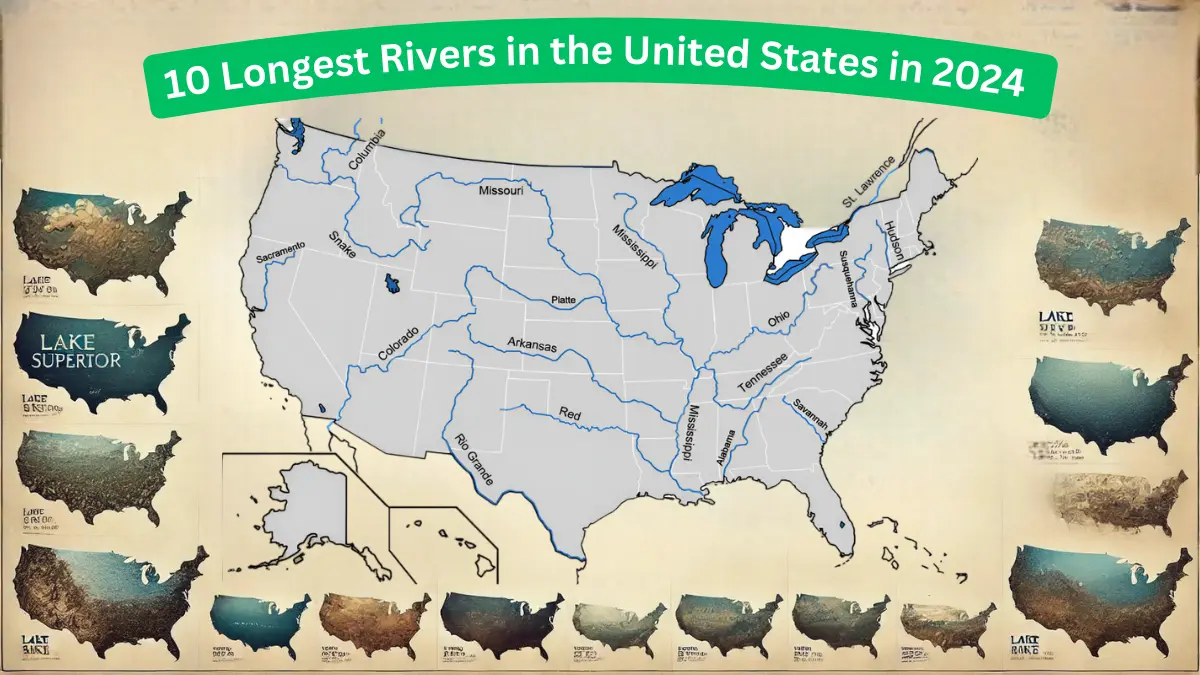Table of Contents
ToggleMissouri River is the longest river in the United States in 2024. Explore the top 10 longest rivers in the United States with detailed insights into their length, the states they traverse, points of origin and mouth, watershed areas, and discharge rates. These remarkable rivers shape the landscape, economy, and culture of the United States, each with its own unique story and significance.

10 Longest Rivers in the United States in 2024
Here is a list of the 10 Longest Rivers in the United States in 2024, including detailed information on their length, states they flow through, origin, endpoint (mouth), watershed area, and discharge:
- Missouri River (2,341 Miles)
- Mississippi River (2,340 Miles)
- Yukon River (1,979 Miles)
- Rio Grande (1,759 Miles)
- Colorado River (1,450 Miles)
- Arkansas River (1,443 Miles)
- Columbia River (1,243 Miles)
- Red River (1,125 Miles)
- Snake River (1,040 Miles)
- Ohio River (979 Miles)
1. Missouri River (2,341 Miles)
The Missouri River is recognized as the longest river in the United States, extending 2,341 miles (3,768 km) from its source to its confluence with the Mississippi River. This major waterway traverses through several states including Montana, North Dakota, South Dakota, Nebraska, Iowa, Kansas, and Missouri. It begins at the Jefferson River in Montana and merges with the Mississippi River in Missouri.
The Missouri River holds the top position in the list of “Longest Rivers in the United States.”
| Attribute | Details |
|---|---|
| Length | 2,341 miles (3,768 km) |
| States | Montana, North Dakota, South Dakota, Nebraska, Iowa, Kansas, Missouri |
| Origin | Jefferson River, Montana (45°55′39″N 111°30′29″W) |
| End Point (Mouth) | Mississippi River, Missouri (38°48′49″N 90°07′11″W) |
| Watershed Area | 529,353 mi² (1,371,017 km²) |
| Discharge | 69,100 ft³/s (1,956 m³/s) |
Interesting Facts About the Missouri River
- Commonly known as the “Big Muddy” due to the high sediment load it carries, giving it a characteristic muddy color.
- The river is a key resource for various uses including agriculture, transportation, and energy production across the central United States.
- It covers a watershed area of approximately 529,353 square miles (1,371,017 km²), making it one of the largest river basins in North America.
- Dams and Reservoirs: The Missouri River is home to several major dams and reservoirs, including the Fort Peck Dam in Montana, the Garrison Dam in North Dakota, and the Oahe Dam in South Dakota. These structures play crucial roles in flood control, irrigation, and hydroelectric power generation.
2. Mississippi River (2,340 Miles)
| Attribute | Details |
|---|---|
| Length | 2,340 miles (3,766 km) |
| States | Minnesota, Wisconsin, Iowa, Illinois, Missouri, Kentucky, Tennessee, Arkansas, Mississippi, Louisiana |
| Origin | Lake Itasca, Minnesota (47°14′22″N 95°12′29″W) |
| End Point (Mouth) | Gulf of Mexico, Louisiana (29°09′04″N 89°15′12″W) |
| Watershed Area | 1,260,000 mi² (3,270,000 km²) |
| Discharge | 650,000 ft³/s (18,400 m³/s) |
The Mississippi River, stretching 2,340 miles (3,766 km), is the second-longest river in the United States. It originates from Lake Itasca in Minnesota and flows southward, eventually emptying into the Gulf of Mexico. This mighty river courses through multiple states, including Minnesota, Wisconsin, Iowa, Illinois, Missouri, Kentucky, Tennessee, Arkansas, Mississippi, and Louisiana.
The Mississippi River holds the second position in the list of “Longest Rivers in the United States.”
Interesting Facts About the Mississippi River
- Often referred to as the “Mighty Mississippi,” this river is integral to American culture and history, serving as a major transportation route and influencing regional economies.
- The river’s extensive watershed spans approximately 1,260,000 square miles (3,270,000 km²), making it one of the largest in the world.
- Dams and Reservoirs: The Mississippi River features several important dams and reservoirs, including the Upper St. Anthony Falls Lock and Dam and the Bonnet Carre’ Spillway. These structures are essential for navigation, flood control, and water management along the river.
3. Yukon River (1,979 Miles)
| Attribute | Details |
|---|---|
| Length | 1,979 miles (3,190 km) |
| States/Provinces | British Columbia (Canada), Yukon Territory (Canada), Alaska |
| Origin | Llewellyn Glacier, British Columbia, Canada (59°35′00″N 133°47′00″W) |
| End Point (Mouth) | Bering Sea, Alaska (62°35′55″N 164°48′00″W) |
| Watershed Area | 324,000 mi² (839,200 km²) |
| Discharge | 224,000 ft³/s (6,340 m³/s) |
The Yukon River stretches 1,979 miles (3,190 km) and flows through Canada and the United States. Originating from the Llewellyn Glacier in British Columbia, Canada, it travels through the Yukon Territory and Alaska before emptying into the Bering Sea. This river is significant for its role in the Klondike Gold Rush and its impact on indigenous communities along its path.
The Yukon River holds the third position in the list of “Longest Rivers in the United States.”
Interesting Facts About the Yukon River
- The river is known for its clear, cold waters and its importance to the local ecosystems and communities.
- It was crucial during the Klondike Gold Rush of the late 19th century, as it served as a key transportation route for prospectors.
- Dams and Reservoirs: The Yukon River has fewer dams compared to other major rivers, but the Bennett Dam in British Columbia is a significant structure that impacts the river’s flow and the surrounding environment.
4. Rio Grande (1,759 Miles)
| Attribute | Details |
|---|---|
| Length | 1,759 miles (2,830 km) |
| States | Colorado, New Mexico, Texas |
| Provinces | Chihuahua, Coahuila, Nuevo León, Tamaulipas (Mexico) |
| Origin | San Juan Mountains, Colorado (37°47′52″N 107°32′18″W) |
| End Point (Mouth) | Gulf of Mexico, Texas/Mexico border (25°57′22″N 97°08′43″W) |
| Watershed Area | 340,000 mi² (870,000 km²) |
| Discharge | 1,300 ft³/s (37 m³/s) |
The Rio Grande spans 1,759 miles (2,830 km) from the San Juan Mountains in Colorado to the Gulf of Mexico. It forms a significant portion of the border between the United States and Mexico. This river is vital for irrigation, agriculture, and water supply for many communities along its course.
The Rio Grande holds the fourth position in the list of “Longest Rivers in the United States.”
Interesting Facts About the Rio Grande
- The river is crucial for irrigation and agriculture, especially in the arid southwestern United States and northern Mexico.
- It has historically served as a significant natural border and played a role in various historical events and treaties.
- Dams and Reservoirs: Important structures along the Rio Grande include the Elephant Butte Dam in New Mexico and the Falcon Dam in Texas, which are essential for managing water resources and flood control.
5. Colorado River (1,450 Miles)
| Attribute | Details |
|---|---|
| Length | 1,450 miles (2,330 km) |
| States | Colorado, Utah, Arizona, Nevada, California |
| Provinces | Sonora, Baja California (Mexico) |
| Origin | Rocky Mountains, Colorado (40°28′20″N 105°49′34″W) |
| End Point (Mouth) | Gulf of California, Mexico (31°48′57″N 114°48′22″W) |
| Watershed Area | 248,000 mi² (642,000 km²) |
| Discharge | 1,400 ft³/s (40 m³/s) |
The Colorado River extends 1,450 miles (2,330 km) from the Rocky Mountains in Colorado to the Gulf of California in Mexico. It is renowned for its dramatic canyons and its crucial role in providing water to the southwestern United States and northern Mexico.
The Colorado River holds the fifth position in the list of “Longest Rivers in the United States.”
Interesting Facts About the Colorado River
- The river is famous for its spectacular canyons, including the Grand Canyon, which it has carved over millions of years.
- It is a vital water source for agriculture, urban areas, and industry in the southwestern United States and northern Mexico.
- Dams and Reservoirs: Major dams on the Colorado River include the Hoover Dam and Glen Canyon Dam, which are essential for water storage, electricity generation, and flood control.
6. Arkansas River (1,443 Miles)
| Attribute | Details |
|---|---|
| Length | 1,443 miles (2,322 km) |
| States | Colorado, Kansas, Oklahoma, Arkansas |
| Origin | Rocky Mountains, Colorado (39°15′30″N 106°20′38″W) |
| End Point (Mouth) | Mississippi River, Arkansas (33°46′30″N 91°04′15″W) |
| Watershed Area | 160,200 mi² (414,910 km²) |
| Discharge | 35,500 ft³/s (1,004 m³/s) |
The Arkansas River flows 1,443 miles (2,322 km) from its origins in the Rocky Mountains of Colorado to its confluence with the Mississippi River in Arkansas. It serves as a major waterway for agriculture and industry across several states.
The Arkansas River holds the sixth position in the list of “Longest Rivers in the United States.”
Interesting Facts About the Arkansas River
- The river is an essential resource for irrigation and transportation in the central United States.
- It played a significant role in the early westward expansion and development of the United States.
- Dams and Reservoirs: Significant dams on the Arkansas River include the Keystone Dam in Oklahoma and the John Redmond Dam in Kansas, which support flood control and water supply needs.
7. Columbia River (1,243 Miles)
| Attribute | Details |
|---|---|
| Length | 1,243 miles (2,000 km) |
| States/Provinces | British Columbia (Canada), Washington, Oregon |
| Origin | Columbia Lake, British Columbia, Canada (50°13′00″N 115°51′00″W) |
| End Point (Mouth) | Pacific Ocean, Oregon/Washington border (46°14′39″N 124°03′29″W) |
| Watershed Area | 279,548 mi² (724,024 km²) |
| Discharge | 273,000 ft³/s (7,730 m³/s) |
The Columbia River stretches 1,243 miles (2,000 km) from Columbia Lake in British Columbia, Canada, to the Pacific Ocean. This river is a vital waterway for the Pacific Northwest, supporting both ecological systems and human activities.
The Columbia River holds the seventh position in the list of “Longest Rivers in the United States.”
Interesting Facts About the Columbia River
- The river is known for its large flow and its importance to the hydroelectric power industry in the Pacific Northwest.
- It provides significant habitat for salmon and other fish species.
- Dams and Reservoirs: The Columbia River is home to numerous major dams, including the Grand Coulee Dam and the Bonneville Dam, which are critical for power generation and flood control.
8. Red River (1,125 Miles)
| Attribute | Details |
|---|---|
| Length | 1,125 miles (1,811 km) |
| States | Oklahoma, Texas, Arkansas, Louisiana |
| Origin | Harmon County, Oklahoma (34°34′35″N 99°57′54″W) |
| End Point (Mouth) | Atchafalaya and Mississippi rivers, Louisiana (31°01′10″N 91°44′52″W) |
| Watershed Area | 65,590 mi² (169,890 km²) |
| Discharge | 30,100 ft³/s (852 m³/s) |
The Red River extends 1,125 miles (1,811 km) from its origin in Harmon County, Oklahoma, to its confluence with the Atchafalaya and Mississippi rivers in Louisiana. It plays an important role in the regional hydrology and agriculture.
The Red River holds the eighth position in the list of “Longest Rivers in the United States.”
Interesting Facts About the Red River
- The river is a crucial resource for the agriculture and industry of the region, especially for its floodplains.
- It has been a significant waterway for transportation and trade throughout its history.
- Dams and Reservoirs: Notable dams on the Red River include the Lake Texoma Dam and the Denison Dam, which help manage floodwaters and provide recreational opportunities.
9. Snake River (1,040 Miles)
| Attribute | Details |
|---|---|
| Length | 1,040 miles (1,674 km) |
| States | Wyoming, Idaho, Oregon, Washington |
| Origin | Rocky Mountains, Wyoming (44°07′49″N 110°13′10″W) |
| End Point (Mouth) | Columbia River, Washington (46°11′10″N 119°01′43″W) |
| Watershed Area | 108,000 mi² (281,000 km²) |
| Discharge | 55,300 ft³/s (1,565 m³/s) |
The Snake River stretches 1,040 miles (1,674 km) from its origins in the Rocky Mountains of Wyoming to its confluence with the Columbia River in Washington. It is a significant river in the Pacific Northwest, supporting both natural ecosystems and human activities.
The Snake River holds the ninth position in the list of “Longest Rivers in the United States.”
Interesting Facts About the Snake River
- The river is known for its dramatic landscapes and is crucial for the region’s agriculture and power generation.
- It supports a variety of wildlife, including several species of salmon and other fish.
- Dams and Reservoirs: Key dams on the Snake River include the Grand Coulee Dam and the Lower Granite Dam, which are vital for irrigation and power production.
10. Ohio River (979 Miles)
| Attribute | Details |
|---|---|
| Length | 979 miles (1,575 km) |
| States | Pennsylvania, Ohio, West Virginia, Indiana, Illinois, Kentucky |
| Origin | Allegheny River, Pennsylvania (40°26′34″N 80°01′02″W) |
| End Point (Mouth) | Mississippi River, Illinois/Kentucky border (36°59′12″N 89°07′50″W) |
| Watershed Area | 204,000 mi² (529,000 km²) |
| Discharge | 308,400 ft³/s (8,733 m³/s) |
The Ohio River spans 979 miles (1,575 km) from its origin at the confluence of the Allegheny and Monongahela rivers in Pennsylvania to its mouth at the Mississippi River. It serves as an important waterway in the eastern United States, playing a significant role in the region’s commerce and transportation.
The Ohio River holds the tenth position in the list of “Longest Rivers in the United States.”
Interesting Facts About the Ohio River
- The Ohio River is a major tributary of the Mississippi River and is vital for transportation and industry in the Midwest and Appalachia.
- It has historically served as an important route for trade and settlement in the United States.
- Dams and Reservoirs: Notable dams along the Ohio River include the New Cumberland Lock and Dam and the Cannelton Lock and Dam, which are crucial for navigation and flood control.
Thank you for reading! If you’re interested in more related topics, click here.
I would also appreciate your support by visiting my second website, Calculationclub.com, which focuses on calculators.


